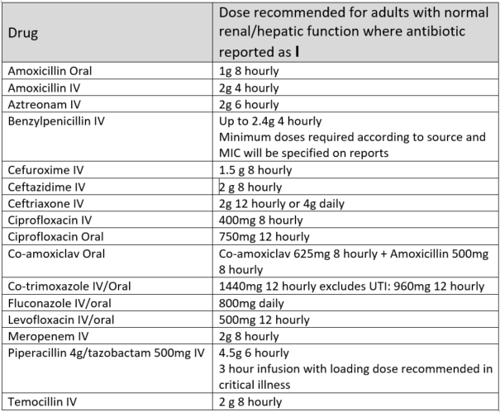Changes to antimicrobial susceptibility reporting from microbiology laboratory from 3rd May 2022

Reporting of antimicrobial susceptibility testing results from microbiology laboratories is changing in line with new European (EUCAST) recommendations. Antibiotic susceptibility will be reported as I as well as the more familiar S and R. Antibiotics reported as I are effective treatment options when given at higher dose and should not be avoided. The new definitions of these are listed below
|
S |
Susceptible at standard dose |
|
I |
Susceptible, at increased exposure/increased dose |
|
R |
Resistant even with increased exposure/dose |
Many reports will be unchanged but below are the situations you are more likely to see I reported or a comment indicating high dose should be used.
|
Organism |
Agents affected |
Comment |
|
Pseudomonas aeruginosa |
Piperacillin-tazobactam Ceftazidime Ciprofloxacin |
Please consider whether treatment is required if reported from a non-sterile site |
|
Haemophilus influenzae |
Oral (not IV) amoxicillin Oral (not IV) co-amoxiclav |
|
|
Streptococcus sp |
Levofloxacin |
High dose already in routine use |
|
E.coli |
Temocillin |
Protected antibiotic Please avoid using this agent if another can be safely used. |
- Please see table overleaf for full list of antimicrobials and doses recommended in adults if reported as
- For paediatrics please refer to id-944-isolates-reported-as-i.pdf (scot.nhs.uk).
- For dosing advice in extremes of weight please discuss with Antimicrobial Pharmacist.
- Refer to the https://bnf.nice.org.uk/ and www.medicines.org.uk for advice on dosing in renal or hepatic impairment but taking into account the higher dose required to treat these organisms effectively. If in doubt discuss with Antimicrobial Pharmacist.
- In certain situations (eg endocarditis), increased doses are recommended even if the antimicrobial is reported as “Susceptible at standard dose” (S). These cases should be discussed with a Microbiologist.
- Dosing recommendations below should only be used when reviewing antimicrobial susceptibility results and do not replace referring to the Empirical Antibiotic Therapy Infection Management Guidelines.

Dosing of topical agents is largely unaffected by this change. Refer to https://bnf.nice.org.uk/ and https://medicines.org.uk for dosing guidance.
